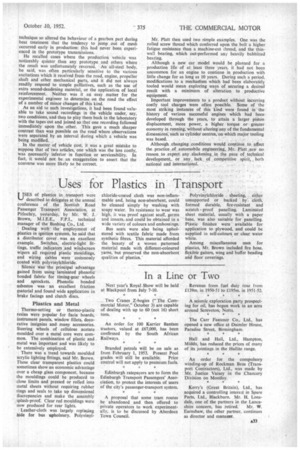Uses for Plastics in Transport
Page 43

If you've noticed an error in this article please click here to report it so we can fix it.
USES of plastics in transport s‘ere described to delegates at the annual conference of the Scottish Road Passenger Transport Association. at Pitlochry, yesterday, by Mr. W. J. Brown, M.1.E.E., F.P.I., technical manager of the Bushing Co., Ltd.
Dealing with the employment of plastics in ignition systems, he said that a distributor cover was an excellent example. Switches, electric-light fittings, traffic indicators and windscreen wipers all required plastic mouldings, and wiring cables were commonly coated with polyvinylchloride.
Silence was the principal advantage gained from using laminated phenolic bonded fabric for timing-gear wheels and sprockets. Phenolic bonded asbestos was an excellent friction material and found wide application in brake facings and clutch discs.
Plastics and Metal
Thermo-setting or thermo-plastic resins were popular for facia boards, instrument panels, window fillets, decorative insignias and many accessories. Steering wheels of cellulose acetate moulded over a metal core were common. The combination of plastic and metal was important and was likely to be extensively employed.
There was a trend towards moulded acrylic lighting fittings, said Mr. Brown. These clear transparent plastics could sometimes show an economic advantage over a cheap glass component, because the mouldings could be produced to close limits and pressed or rolled into metal sheets without requiring rubber rings and seals to take up dimensional discrepancies and make the assembly splash-proof. Clear red mouldings were now produced for rear lights.
Leather-cloth was largely replacing hide for bus upholstery. Polyvinyl
chloride-coated cloth was non-inflammable and, being non-absorbent, could be cleaned simply by washing with soapy water. Its resistance to wear was high. it was proof against scuff, germs and insects, and could be obtained in a wide variety of colours and embossings.
Bus seats were also being upholstered with textile fabric made from synthetic fibres. This material afforded the beauty of a woven patterned material made with different-coloured yarns, but preserved the non-absorbent qualities of plastics.
Polyvinylchloride sheeting, either unsupported or backed by cloth, formed durable, fire-resistant and scratch proof panelling. Laminated sheet material, usually with a paper base, was also suitable for panelling. Plastic finishes were available for application to plywood. and could be supplied in self-colours. or clear water white.
Among miscellaneous uses for plastics, Mr. Brown included fire hose. flexible gaiters, wing and buffer beading and floor coverings.












































































